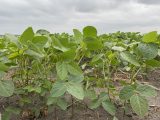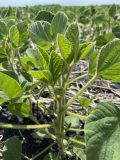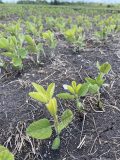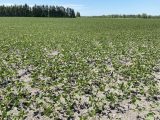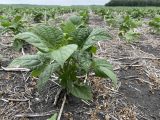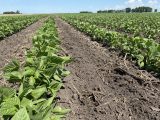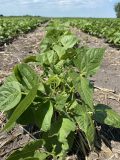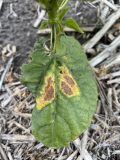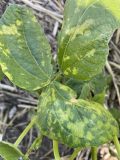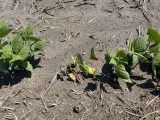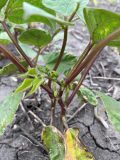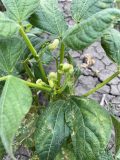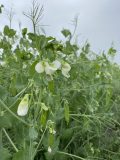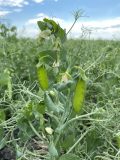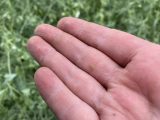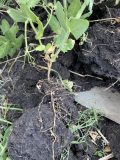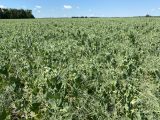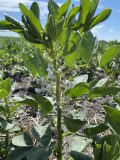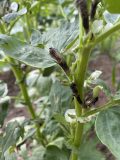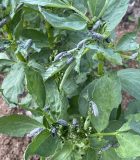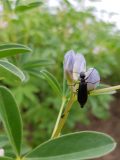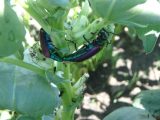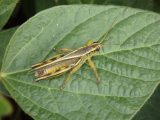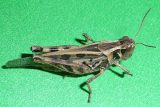JULY 7, 2021
- Crop Update
- Blister Beetles
- Assessing Grasshopper Damage
- Soybean Nodulation Assessment
- Investigating N Rescue in Field Peas
- Late Season Weed Scouting and Managing Kochia in Soybeans and Pulses
- Foliar Fungicide Decision Making for Dry Beans in a Dry Year
- On-Farm Network Update
Listen to The Bean Report:
Crop Update
- Mainly at R1 (beginning bloom), with anywhere from 4-8 trifoliate leaves. The most advanced soybean crops are reaching the R2 (full bloom) stage this week.
- Soybeans do not love dry conditions, but they remain resilient at this point in the growing season. Some crops are stressed and flipping their leaves during the day, but many crops – especially those grown in soils with greater water-holding capacity – are looking good. Some fields that held water are now showing signs of Phytophthora root rot.
- Some late flushes of IDC were reported last week, but recovery has overall been great over the past couple of weeks in fields that are prone to this condition, including the variety evaluation site near Winnipeg. Potassium (K) deficiency symptoms can also be found at this time in field pockets where levels are low.
- Extended hypocotyls are a common sight this year, suggesting we may have higher pod heights at harvest. Very warm temperatures during early growth have likely contributed, along with heavier crop residue that has inspired plants to reach for the sky. Interestingly, thinner-stemmed plants coupled with this elongation are starting to bend or “gooseneck” as they grow.
- The flowering stages are a great time to assess nodulation in soybeans.
- Throughout July, keep an eye on foliar disease development, continue to monitor grasshopper pressure and be on the lookout for the potential arrival of soybean aphids and spider mites. The latter enjoys dry conditions and fields that have previously been sprayed with insecticide (due to the loss of natural enemies).
- Range from V3 to V8, with many dry bean crops now at the flower bud stage. Flowers are expected to start opening in the most advanced fields toward the end of the week.
- Inter-row cultivation passes have been made recently for weed control in wide-row dry beans.
- Disease symptoms have started to show up in dry bean crops, including bacterial blight, triggered by previous damage to plants (e.g., from heavy winds). Root rot symptoms can also be found, but at very low levels.
- Mainly at the R3 (flat pod) stage, with some fields approaching R4 (full pod).
- Under the hot, dry conditions, pea crops are advancing quickly, and some are under a great deal of stress. We have observed the odd case of rapid growth, appearing as leaf “bubbling,” reduced plant height across the province and in the most severe cases, drooping of plant tips and crisping up of the lower canopy.
- Mycosphaerella freckling has been found, but mainly at field edges or around drown-out spots. Little to no disease means foliar fungicide is unlikely to be economical. Follow the Fungicide Decision Worksheet for Managing Mycosphaerella Blight in Field Peas fact sheet, continue to monitor the crop for symptoms until the R4 (full pod) stage, and consider yield potential and the overall payoff when making fungicide decisions.
- Root rot is present in fields that were previously wet, or in fields that held water and have since dried up. Infected roots that are now experiencing dry conditions cannot support themselves, meaning they cannot properly fix nitrogen or take up other nutrients and water.
- Pea aphids are present, but at numbers below economic thresholds so far. Continue to check plant tips or sweep fields for pea aphids until the full pod (R4) stage.
- Pea nodulation has been variable across Manitoba. Some fields have great nodulation, while others have poor to no nodulation. Possible causes include high soil nitrate levels, inoculant failure or root rot. Check out the section below on how we’re investigating N rescue in peas this year.
- Mainly R3 (full flower), with young pods beginning to protrude from the most mature flowering nodes.
- In rainfed fields, these water-loving plants are in much need of moisture. Plant height has also been reduced under the hot, dry conditions Manitoba is experiencing.
- Blister beetles have been showing up around the province and they love faba beans. Watch for them, lygus bugs and pea aphids throughout July.
Blister Beetles
Blister beetles tend to cluster on plants because they emit a pheromone that attracts other blister beetles. This cluster feeding is quite noticeable, but on a whole-field basis, it is usually not economical to control them. In fact, some species of blister beetles will actually feed on grasshopper eggs. These are the black and grey blister beetles we often see (in the genus, Epicauta).
These beetles may pose a threat to faba beans if the crop’s end use is livestock feed, due to the toxin, cantharidin. Spot spraying of blister beetle patches could make sense in severe cases, but there are no products registered for control of blister beetles in pulse and soybean crops.
Assessing Grasshopper Damage
The warm, dry conditions this season have been conducive for grasshopper development and damage has been reported in fields within southern Manitoba. There may be lots of grasshoppers jumping around, but of the 85 grasshopper species in Manitoba, only four have the potential to become crop pests, including the migratory, twostriped, clearwinged and packard grasshoppers. The most common grasshopper species found this season is the clearwinged grasshopper, which is primarily a grass feeder that will not feed on beans.
Thresholds and tips for control:
- Grasshoppers are difficult to count in the field, but if you are seeing 8-12 grasshoppers per square metre, control is usually warranted.
- Defoliation thresholds may be easier to follow. For soybeans and dry beans, the threshold is 30% defoliation pre-bloom and 15% from bloom to pod fill. With most soybean crops now flowering, follow the threshold of 15% defoliation. Assess defoliation on 2 random plants within 5 different areas of the field for an accurate estimate.
- Sweep net sampling is not recommended for assessing populations but is useful for identifying the development stage of grasshoppers for treatment timing.
- Grasshopper populations are typically concentrated along roadsides and field edges, so a border spray may be all that is needed.
- The best time to control grasshoppers is after most have hatched and before most have turned into adults. As of June 27th (Manitoba Crop and Pest Report), grasshoppers were predicted to be mostly in the 4th to 5th instar, with grasshoppers now approaching the adult phase. They can still be controlled at the adult stage, but it becomes more difficult, as they can fly and disperse more easily, and some insecticides do not work as well on adults. Higher rates of insecticide may be needed at the adult stage, meaning control also becomes more expensive.
Consider beneficial insects in your grasshopper management decisions. Ground beetles, crickets, larvae of blister beetles and bee flies are all predators that feed on grasshopper eggs. Spiders, robber flies, some wasps, and different types of birds and rodents will feed on grasshopper nymphs and adults. There are also parasitoids and pathogens that can help control grasshopper populations. Also consider pollinators that might be present. If a crop must be sprayed at the flowering stage, apply as late in the day as possible and choose an insecticide that is not harmful to pollinators (e.g., Coragen).
Soybean Nodulation Assessment
The R1 stage is the best time to assess nodulation in soybeans. This will tell you if the crop can supply itself with enough nitrogen (N) through biological N fixation.
- Dig up random plants across the field – about 5-10 plants in 2-3 different areas. Soak the roots to avoid breaking off nodules as you remove soil.
- Count the number of nodules per root system. If each plant has at least 10 root nodules of any size, your soybean crop has achieved adequate nodulation.
- Cut open random nodules to ensure they are actively fixing N. A pinkish-red interior means they are active. Leghemoglobin in the nodules, like hemoglobin in blood, is produced by rhizobia bacteria during N fixation and changes colour when exposed to oxygen.
- While roots are exposed, take the time to assess the shape and growth pattern of roots (e.g., if they are growing sideways could mean compaction issues), and the colour and condition of the roots (e.g., reddish colour, pinching or lack of lateral roots could mean root rot).
If the crop is yellowing and nodules are either absent or not actively fixing N, a rescue application of N may be necessary at R2 (full flower) to R3 (early pod). Broadcast granular N or direct liquid N below the crop canopy at 50 lbs N/ac. Liquid N contact with leaf material can burn the foliage and reduce yield.
Investigating N Rescue in Field Peas
Rescue applications in peas have not been well researched. This year, we’ve identified a few fields with insufficient nodulation that are showing signs of nitrogen deficiency (yellowing of lower leaves and crop stunting). To investigate how peas may respond to an in-season nitrogen application we’ve set up replicated and randomized small plots in two fields in western Manitoba comparing 50 lbs N/ac broadcast SuperU at R2 (flowering) and R3 (flat pod) versus untreated. Crop and soil characteristics from poor and good areas of the fields before the application of nitrogen are in the table below.

Late-Season Weed Scouting
Weeds growing now are likely setting seed this year. Knowing which weeds will be growing in your field next year helps you plan a herbicide program for the 2022 crop. It’s also an opportunity to evaluate the effectiveness and weaknesses of this year’s weed control program.
If you’re managing herbicide-resistant kochia that has colonized your saline areas, control patches and herbicide escapes. Mow, bale, graze, spot till, burn or hand pull surviving plants before they set seed. Kochia has low seedbank persistance, so preventing seed set (of 30,000 seed/plant) will help reduce the problem for future years.

Take a careful look at pigweed escapes to ensure they are not tall waterhemp. Two differentiators that are mainly used to identify waterhemp versus redroot pigweed are hairs on the stem and the seed head. Waterhemp is a Tier 1 noxious weed and must be destroyed if found. If you suspect it in your field, contact Kim Brown-Livingston, Weeds Specialist with Manitoba Agriculture and Resource Development.
Foliar Fungicide Decision Making for Dry Beans in a Dry Year
- Foliar fungicides to control white mould are preventative, meaning they are applied before disease symptoms are visible.
- White mould prevalence and severity in dry bean fields have been low for the last three years (2018-2020). Whether fungicide applications will be warranted in 2021 will depend on the yield potential of the crop, the amount of precipitation received in July around flowering and if recent, previous broadleaf crops in the field or vicinity have had high Sclerotinia/white mould levels, contributing more spore-producing sclerotia bodies to the area.
- The Fungicide Decision Worksheet for Managing White Mould in Dry Beans (also available in the Bean App) can help determine the risk of disease development, based on environmental and agronomic factors, and aid in the decision of whether or not to apply a fungicide.
- The R2/early pin bean stage is the best time to apply fungicide for effective white mould control. This stage coincides with flowering (100% of plants with an open blossom) and early pod development (first pin-pods are 0.5 to 1″ long).
On-Farm Network Update
The OFN team has been busy in the field! Plant counts, soil sampling and nodulation ratings have kept us hopping around the province for the last couple of weeks. We did pea nodulation ratings at our pea inoculant trials last week and nodulation ratings will soon be underway at our dry bean nitrogen trials as well. Fungicide trials are in the process of being established, and while it isn’t a high disease pressure year, we are looking forward to taking a close look at disease symptoms in soybeans, dry beans, peas and faba beans. We’re also enjoying making observations, like the colour difference evident in the 0 N check strips of a dry bean nitrogen trial, for example!

Nitrate Update
In the last Bean Report, we shared our investigation into next-level nitrate levels that were showing up in spring soil tests of fields across Manitoba. At 15 fields we’re regularly soil sampling microplots every two to three weeks to investigate this. The first two samples of 11 fields have been completed – nitrates have gone down in seven fields, gone up in three fields and have remained the same in one field. We are sampling another four this week and will continue to monitor levels for the rest of the season.
In these fields, high nitrate levels have inhibited nodulation. So far only three fields have since had nitrate levels decline below 50 lbs N/ac where we may see deficiency symptoms develop. Since these high nitrate levels seem to occur in fields throughout Manitoba, be sure to check nodulation in your pulse and soybean crops this year.


